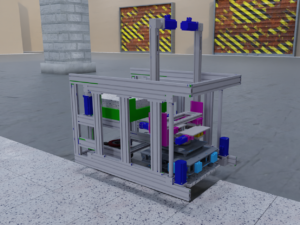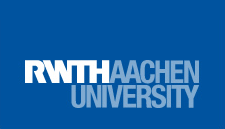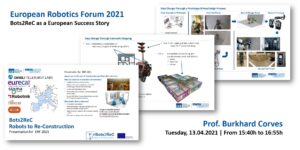Kategorie: ‘Rough Environments’
Presentation of the “ErgoFli” project at the KT Colloquium 2022

The aim of the ZIM-funded project “ErgoFli” is to develop an intelligent, semi-automatic tiling aid. Its intuitive user interface, automated handling of tiles and tile adhesive, and intelligent control system are expected to reduce non-ergonomic postures by up to 66%. The ErgoFli can be moved with a motorised drive and uses linear laying kinematics to lay tiles without direct wall contact using the buttering-floating method. Tiles in two formats, 30x60 cm or 60x60 cm, can be laid in a cross bond. The robot is equipped with a tile and tile adhesive reservoir so that it can be used for at least 30 minutes without refilling and can lay 12 m2 per hour while maintaining the required standard flatness tolerances.
Using a digital twin, an early prototype has already been tested in various scenarios. While the prototype is being designed in standard CAD software, the actual model is being integrated into the Gazebo simulation environment in parallel. This enables continuous integration and testing of control system software packages in application-related scenarios. For example, real test data can be transferred to the digital twin via a closed-loop simulation. The three laser profile sensors of the tile gripper are attached to a prototype gripper and mounted on a UR10 robot arm. The measured values from the sensors can then be transferred to the digital twin in the simulation, despite the different kinematics. In this way, the position control of the gripper can be integrated into the overall system at an early stage by measuring the joint widths.
Contacts:
Jan Wiartalla
Marius Gürtler
Bots2ReC beim ERF2021
Das European Robotics Forum ist das größte Treffen der Robotikexpert*innen in Europa. Unser Projekt Bots2ReC wurde von der Kommission als „Sucess Story“ benannt und wird am Dienstag, den 13.04. in der Session von 15:40 Uhr bis 16:55 Uhr von Prof. Corves vorgestellt. Dabei wird das Entfernen von Asbest aus Wohnhäusern thematisiert und der im Projekt entwickelte teilautomatisierte Prozess inklusive der einzelnen Entwicklungsstufen erläutert. Anhand zahlreicher Videos werden die Herausforderungen bei der Automatisierung der Baubranche aufgezeigt und mögliche Lösungen anhand unserer Prototypen präsentiert. Wir freuen uns sehr über diese Chance, unsere Ergebnisse vor einem so fachkundigen Publikum vorstellen zu dürfen.
Ansprechpartner:
IGMR Seminar 26.01.2021: Robert Grafe, Deutsches Rettungsrobotik-Zentrum e.V.
Unbemannte Systeme in der Gefahrenabwehr, der Aufbau des Deutsches Rettungsrobotik-Zentrums.
https://youtu.be/anZtJAajQy0
Wir begrüßen Herrn Grafe vom DRZ zum IGMR Seminar. Auch dieser Veranstaltung wird weiterhin virtuell durchgeführt:
Unbemannte Systeme in der Gefahrenabwehr, der Aufbau des Deutsches Rettungsrobotik-Zentrums Die Nutzung unbemannter, bodengebundener Systeme bietet großes Potential, Einsatzkräfte von Hilfsorganisationen und Feuerwehren bei besonders gefährlichen oder zeitraubenden Einsätzen zu unterstützen. Auf Grund der anspruchsvollen Aufgaben und Szenarien ist der Sprung von der Forschung in die reale Nutzung jedoch bisher nur vereinzelt geglückt. Der Vortrag stellt diesen Stand von Forschung und Entwicklung dar und beschreibt den Ansatz, welcher mit der Gründung des Deutschen Rettungsrobotik-Zentrums beschritten wird, um die Realisierung von praxis-/ und produktnahen Lösungen zu fördern.
Dienstag, 26. Januar 2021 16:30 Uhr in Zoom
Zoom Meeting Informationen:
https://rwth.zoom.us/j/98454895570?pwd=NkpiSWkyaTJtdWlralJrSUtnMDdDZz09
Meeting-ID: 984 5489 5570
Kenncode: 186393
Die Datenschutzhinweise zur Nutzung von Zoom und eine Handreichung für Teilnehmer (Studierende) können von den Seiten des CLS der RWTH Aachen University heruntergeladen werden.
Die Veranstaltungen im Wintersemester 2020/2021 werden in Zusammenarbeit mit dem VDI-GPP-Arbeitskreis des Bezirksvereins Aachen durchgeführt.
Weitere Informationen können auch dem Blog-Beitrag IGMR als Mitglied des Deutsches Rettungsrobotikzentrum e.V entnommen werden.
Ansprechpartner:
Robot Companion: A mobile helper in case of need
Robot Companion is a framework to implement robot tracking systems in a simple and cost-saving way. For this purpose, IGMR develops methods for tracking with different sensors (laser, radar, camera), agile path planning and actuation.
The current objective of Robot Companion is to provide a robot for emergency rescue. In doing so, the robot will autonomously follow first responders and enable the transport of materials and equipment, as well as the removal of debris and casualties. A first path to this vision was implemented with the basic module. The basic module has methods for tracking with a camera and laser, and enables autonomous tracking of an operator.
The video shows the tracks of the vertical and horizontal trackers, as well as the state of detection (top right). In a tracking test, 100% accuracy was achieved at low speeds.
https://youtu.be/imU8j2zlQrQ
Project website:
https://www.igmr.rwth-aachen.de/index.php/de/rob/rob-comp
Contact:




